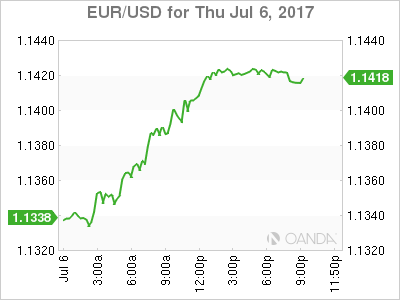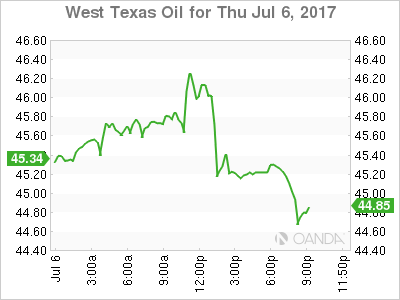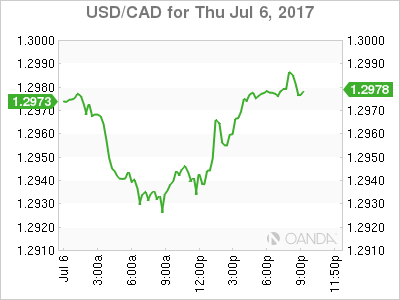Central Banks and Geopolitics Pressure Dollar
The US dollar is lower against most of the majors as a host of central banks have joined the Fed’s hawkish club in words if not in actions. The minutes from the European Central Bank (ECB) released on Thursday and disappointing private payrolls in the US had the dollar losing ground ahead of the U.S. non farm payrolls (NFP) to be published on Friday, July 7 at 8:30 am EDT.
Job gains have been steady in the US with employment the most reliable pillar of the economic recovery. Wage growth has been slow and with low inflation a concern for the U.S. Federal Reserve it will be one of the most discussed indicators. The US is expected to have gained 175,000 positions with hourly earnings rising 0.3 percent on a monthly basis.
Geopolitics will also be front and center as the G20 meeting is underway in Hamburg, Germany. Highlights will include the first face-to-face meeting with Vladimir Putin as well as several trade talks as American protectionism has been criticized.

The EUR/USD gained 0.849 percent in the last 24 hours. The single currency is trading at 1.1423 and was boosted by the release of the European Central Bank (ECB) meeting notes. The EUR has appreciated versus the USD as more central banks have been optimistic about economic growth despite low inflation. The ECB has a long way to go before it can start a tightening monetary policy, but so far the rhetoric has hinted at tapering of its quantitive easing program.
The ADP report was lower than expected but still points to a solid job market, the same story as the unemployment claims that also underwhelmed this week. The pressure is on the NFP jobs report to dispel the doubts surrounding wage growth and its implications on inflation that could reduce the tightening of monetary policy by the Fed. The central bank is expected to start reducing its balance sheet and hike rates one more time before the year ends.

Oil prices rose 0.5 percent on Thursday. The West Texas Intermediate is trading at $45.24 after the Energy Information Administration (EIA) weekly crude inventories report showed a bigger than expected drawdown. US crude stocks fell by 6.3 million barrels last week and let the total inventories at a six month low. The black stuff could not hold to most of the drawdown related gains as it backtracked as there are still concerns about oversupply. American output has increased and it has all but offset the efforts from the Organization of the Petroleum Exporting Countries (OPEC) who signed a production cut agreement with other major producers to limit the global supply.
The production cut agreement has enjoyed from full compliance in the first six months and was extended for another 9 after its effects have only managed to stabilize oil prices. Demand remains soft even as energy importing nations are running out of storage as they take advantage of current low prices.
Investment banks have reduced their price forecasts into the $50 to $55 price range for the end of the year. The battle between OPEC deal agreement producers and the US will continue to dictate the price of energy.

The USD/CAD lost 0.239 in the last 24 hours. The currency pair is trading at 1.2953 after a mixed bag of economic indicators for the US dollar. The private payrolls ADP report disappointed with a 158,000 positions added, after a forecast of 184,000 and a downward revision that reduced by 23,000 last months massive gain. US unemployment claims came in higher than anticipated by a small margin but added to the pessimism about US employment. The ISM non-manufacturing PMI exceeded the forecast by reaching 57.4 in June. Both ISM surveys showed an overall strength in the manufacturing and services sectors.
The rise of oil prices after the lower than expected inventories boosted the CAD but the currency pair remains range bound ahead of the U.S. non farm payrolls (NFP) due on Friday, July 7 at 8:30 am EDT. The forecast for US jobs is for a gain of 175,000 new positions added in June. Last month’s report was 23,000 jobs lower than forecast and the slowdown in the private sector has raised concerns that it could come under forecasts. Given the focus of the Fed on inflation the market will be focusing on the average hourly earnings as a measure of inflation. Wages are forecasted to have grown 0.3 percent from last month.
Canadian employment data will also be released at the same time with a gain of 11,000 expected after the monster 54,500 gain last month. The CAD has appreciated since June 11 when the Bank of Canada (BoC) turned hawkish saying the rate cuts from 2015 have done their job. The central bank is widely anticipated to hike rates this year with the July 12 meeting at more than 50 percent probability.
Market events to watch this week:
Friday, July 7
4:30 am GBP Manufacturing Production m/m
8:30 am CAD Employment Change
8:30 am CAD Unemployment Rate
8:30 am USD Average Hourly Earnings m/m
8:30 am USD Non-Farm Employment Change















